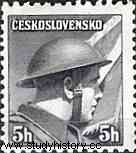The Brodie helmet, also known as the shrapnel helmet or the Tommy helmet, is a steel helmet designed and patented in 1915 by John Brodie.

At the start of the First World War, none of the belligerent countries had planned a steel helmet for his fighters. Most soldiers went into battle with a cloth headdress offering no protection against modern weapons. Only German troops were equipped with the spiked helmet, made of boiled leather with a canvas tarp to protect the leather.
The French army suffered a large number of losses due to mortal head wounds, which led to the adoption of the steel helmet, at first simple headstalls, replaced by the Adrian helmet in the summer of 1915 It quickly replaced the kepi in the French army, then was adopted by the Belgian and Italian armies. The War Office then requested a similar helmet.
The Invention department of the War Office evaluated the French helmet. He found it insufficiently solid and too complex to have it made by small factories. Brodie's model offered the advantage of being machinable from a single sheet of pressed metal, which gave it extra strength. It began to be distributed from the fall of 1915, but was not available in large quantities until the spring of 1916. It was during the battle of Saint-Éloi, in April 1916, that it was used for the first time in combat.
The other armies of the British Empire also used the Helmet helmet, and the US Army acquired 400,000 Helmet helmets in 1917, until the United States began to manufacture them in January 1918 (these are the M1917).
The circular Brodie helmet, which earned him the nickname soup plate, mainly protects the head from shrapnel.
The original model (Type A), is made of normal steel with an overhang of 4 to 5 cm. It was only produced for a few weeks, before the Type B was introduced. It is made of stronger steel, high in manganese, and has a more rounded crown. It was replaced in May 1916 by the Mark I, with a matte surface, which therefore did not shine in the sun. In 1917, padding made the helmet more comfortable. At the end of the war, the helmets bore, painted, the insignia of the soldier's unit.
The Brodie helmet was used in the US Army until 1942, with minor modifications, until it was replaced by the M1 helmet.
